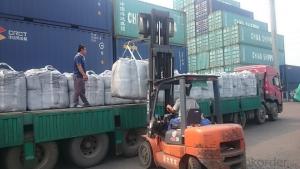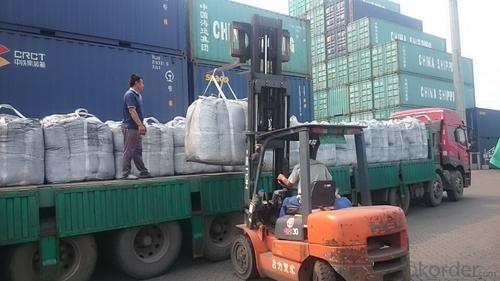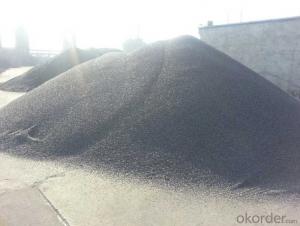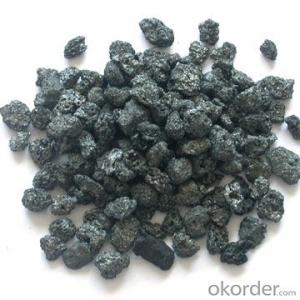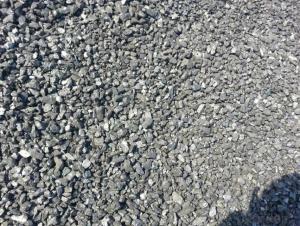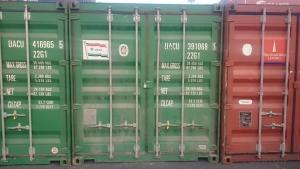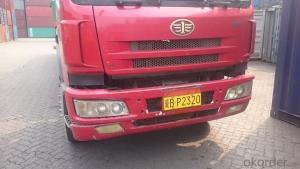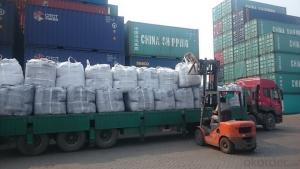Used in EAF as Charge Coke for for Foundry Plants with VM 2%max
- Loading Port:
- Tianjin
- Payment Terms:
- TT OR LC
- Min Order Qty:
- 21 m.t.
- Supply Capability:
- 6000 m.t./month
OKorder Service Pledge
OKorder Financial Service
You Might Also Like
Introduction:
Calcined anthracite can be called carbon additive, carbon raiser, recarburizer, injection coke, charging coke, gas calcined anthracite.
Carbon Additive/Calcined Anthracite Coal may substitute massively refinery coke or graphite. Meanwhile its cost is much less than the refinery coke and graphite. Carbon Additive is mainly used in electric steel ovens, water filtering, rust removal in shipbuilding and production of carbon material.
It has good characteristics with low ash, low resistivity, low sulphur, high carbon and high density. It is the best material for high quality carbon products. It is used as carbon additive in steel industry or fuel.
Features:
Best quality Taixi anthracite as raw materials through high temperature calcined at 800-1200 ℃ by the DC electric calciner with results in eliminating the moisture and volatile matter from Anthracite efficiently, improving the density and the electric conductivity and strengthening the mechanical strength and anti-oxidation, It has good characteristics with low ash, low resistivity, low carbon and high density. It is the best material for high quality carbon products, it is used as carbon additive in steel industry or fuel.
Specifications:
F.C.% | 95MIN | 94MIN | 93MIN | 92MIN | 90MIN | 85MIN | 84MIN |
ASH % | 4MAX | 5MAX | 6 MAX | 6.5MAX | 8.5MAX | 12MAX | 13MAX |
V.M.% | 1 MAX | 1MAX | 1.0MAX | 1.5MAX | 1.5MAX | 3 MAX | 3 MAX |
SULFUR % | 0.3MAX | 0.3MAX | 0.3MAX | 0.35MAX | 0.35MAX | 0.5MAX | 0.5MAX |
MOISTURE % | 0.5MAX | 0.5MAX | 0.5MAX | 0.5MAX | 0.5MAX | 1MAX | 1MAX |
Pictures

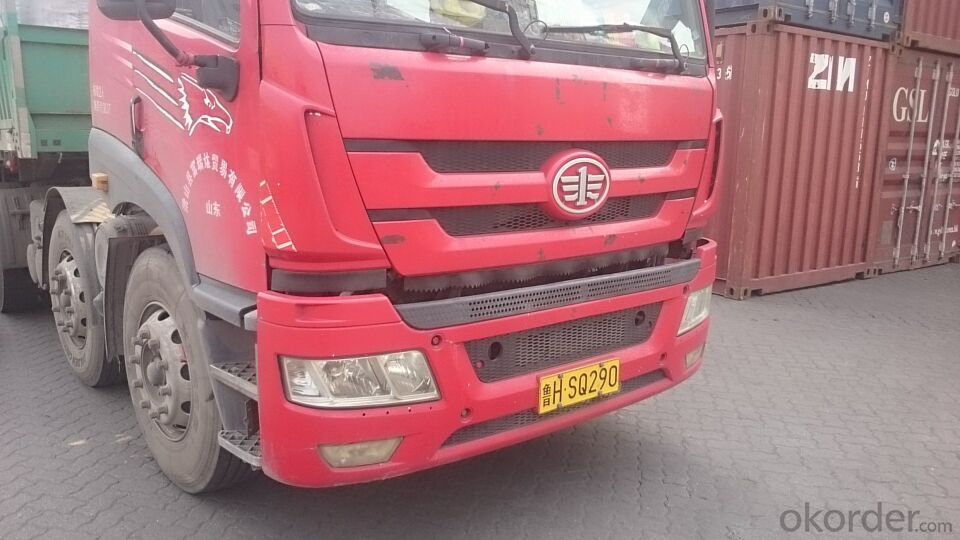


FAQ:
Packing:
(1). Waterproof jumbo bags: 800kgs~1100kgs/ bag according to different grain sizes;
(2). Waterproof PP woven bags / Paper bags: 5kg / 7.5kg / 12.5kg / 20kg / 25kg / 30kg / 50kg small bags;
(3). Small bags into jumbo bags: waterproof PP woven bags / paper bags in 800kg ~1100kg jumbo bags.
Payment terms
20% down payment and 80% against copy of B/L.
Workable LC at sight,
- Q: How is carbon used in the electronics industry?
- The electronics industry utilizes carbon in various ways. Carbon is commonly used to produce carbon-based materials like carbon nanotubes and graphene, which have distinctive properties that make them ideal for electronic devices. Carbon nanotubes, for instance, are cylindrical structures formed by arranging carbon atoms in a tube-like fashion. They possess excellent electrical conductivity, thermal conductivity, and mechanical strength. These attributes make them valuable in electronic applications such as transistors, sensors, and batteries. By using carbon nanotubes, smaller and more efficient electronic components can be created, resulting in smaller, faster, and more powerful devices. On the other hand, graphene is a single layer of carbon atoms arranged in a two-dimensional lattice. It exhibits exceptional conductivity of electricity and heat, as well as remarkable mechanical strength. These properties make it suitable for applications like flexible displays, touchscreens, and energy storage devices. The use of graphene-based electronics has the potential to revolutionize the industry by enabling the integration of flexible and transparent devices into various surfaces and objects. Moreover, carbon is employed in the production of carbon-based resistors and electrodes. Carbon resistors are commonly used in electronic circuits to regulate the flow of current. They provide stable and predictable resistance, ensuring the proper functioning of electronic devices. Carbon electrodes, on the other hand, enable the flow of electrical charge in batteries, fuel cells, and capacitors. Additionally, carbon plays a crucial role in the manufacturing of printed circuit boards (PCBs), which are essential components in electronic devices. PCBs provide a platform for interconnecting various electronic components. Carbon is utilized as a conductive ink in the fabrication of PCBs, allowing for the creation of intricate circuit patterns. In conclusion, carbon is an indispensable element in the electronics industry. Its unique properties enable the development of advanced materials and components that enhance the performance and functionality of electronic devices. From carbon nanotubes and graphene to resistors and electrodes, carbon-based materials are shaping the future of electronics by enabling smaller, faster, and more efficient devices.
- Q: What are the sources of carbon emissions?
- Human activities, particularly the burning of fossil fuels like coal, oil, and natural gas, are the primary cause of carbon emissions. The largest contributor to carbon emissions is the utilization of fossil fuels for generating electricity, transportation, and various industrial processes. Power plants that utilize coal and natural gas play a significant role in emitting carbon, as do vehicles that run on gasoline and diesel. Besides, carbon emissions also result from industrial processes, mainly in sectors like cement production and steel manufacturing. These processes release carbon dioxide (CO2) during the chemical reactions involved in producing these materials. Deforestation and changes in land use are another significant source of carbon emissions. When forests are cleared, the carbon stored in trees is released into the atmosphere as CO2. Moreover, the loss of forests reduces the Earth's capacity to absorb CO2 through photosynthesis, worsening the situation. Agricultural activities, particularly livestock farming, contribute to carbon emissions through the release of methane (CH4) from animals' digestive systems and the decay of organic matter. The use of synthetic fertilizers in agriculture further adds to carbon emissions as they release nitrous oxide (N2O), a potent greenhouse gas. Other sources of carbon emissions include waste management practices, particularly the decomposition of organic waste in landfills, and specific industrial processes that release other greenhouse gases like hydrofluorocarbons (HFCs) and sulfur hexafluoride (SF6). It is crucial to note that although natural processes like volcanic eruptions and wildfires also release carbon dioxide into the atmosphere, their contribution is significantly smaller compared to human-induced emissions.
- Q: What are the different types of carbon steel?
- Carbon steel is a versatile and widely used material in various industries due to its strength, durability, and affordability. There are several different types of carbon steel, each with its own unique properties and applications. 1. Low Carbon Steel: This type of carbon steel contains a low amount of carbon, typically up to 0.25%. It is the most commonly used form of carbon steel due to its ease of fabrication, weldability, and affordability. Low carbon steel is used in applications such as construction, automotive manufacturing, and general engineering. 2. Medium Carbon Steel: With a carbon content ranging between 0.25% and 0.60%, medium carbon steel offers increased strength and hardness compared to low carbon steel. It is commonly used in machinery parts, axles, gears, and shafts that require higher levels of toughness and wear resistance. 3. High Carbon Steel: High carbon steel contains a carbon content of 0.60% to 1.00%. It has excellent strength and hardness but is less ductile and more brittle compared to low and medium carbon steels. High carbon steel is commonly used in applications such as cutting tools, springs, and high-strength wires. 4. Ultra-High Carbon Steel: This type of carbon steel contains a carbon content greater than 1.00%, typically ranging from 1.20% to 2.50%. It possesses extremely high hardness and is often used in specialized applications such as knives, blades, and tools that require exceptional sharpness and wear resistance. 5. Carbon Tool Steel: Carbon tool steel refers to a group of steels that contain additional alloying elements such as chromium, vanadium, or tungsten. These alloying elements enhance the steel's hardness, wear resistance, and heat resistance, making it suitable for tool and die making, cutting tools, and molds. It is important to note that the carbon content of steel determines its strength, hardness, and other properties. The choice of carbon steel type depends on the specific application, desired characteristics, and manufacturing requirements.
- Q: Paint paint fluorocarbon paint which expensive?
- After several decades of rapid development, fluorine coating has been widely used in various fields of construction, chemical industry, electrical and electronic industry, machinery industry, aerospace industry, household products. Become the acrylic coating, polyurethane coatings, silicone coatings and other high-performance coatings, the highest overall performance of the coating brand. At present, there are three types of fluoro resin coatings, such as PTFE, PVDF and PEVE, which are widely used.In short, paint is fluorocarbon paint evolved =. = which of the more expensive ones depends on the brand of paint?.Hope the answer helps! ~
- Q: How does carbon contribute to the flavor of food?
- There are multiple ways in which carbon, found in charcoal or charred substances, can enhance the flavor of food. Firstly, when food is cooked over charcoal, the carbon gives it a smoky taste and aroma, which enhances the overall flavor. This smokiness is particularly desirable in dishes such as barbecued meats, vegetables, and certain cheeses, as it adds a unique and enjoyable element to the taste. Additionally, carbon can serve as a natural filter, absorbing and eliminating impurities from food and drinks. This filtration process helps to get rid of unpleasant smells and flavors, resulting in a cleaner and more refined taste. For instance, activated carbon is often used in the production of alcoholic beverages like whiskey or vodka to remove impurities and create a smoother and more flavorful drink. Moreover, carbon can contribute to the development of desirable texture and color in certain foods. When sugar or other carbohydrates are heated, they undergo caramelization, a process in which the sugars react with heat to form a complex mixture of carbon compounds. This caramelization process creates rich, golden-brown hues and a unique depth of flavor, enhancing the overall taste experience. Lastly, carbon plays a crucial role in the fermentation process, which is essential in producing various types of food and drinks. During fermentation, microorganisms consume sugars and release carbon dioxide, which contributes to the texture, flavor, and carbonation of the final product. This is particularly evident in bread, beer, wine, and other fermented foods, where the presence of carbon dioxide adds lightness, complexity, and effervescence to the flavor. To summarize, carbon enhances the flavor of food through its ability to impart smokiness, act as a natural filter, facilitate caramelization, and participate in fermentation processes. Its presence in different forms enhances the taste, texture, and overall enjoyment of a wide range of food and drinks.
- Q: How does carbon affect the formation of toxic algal blooms?
- Toxic algal blooms can be influenced by carbon in both direct and indirect ways. Eutrophication is one direct effect, where carbon, in the form of organic matter, enters water bodies from various human activities. This excess carbon acts as a nutrient for algae, promoting their rapid growth and leading to algal blooms. Another direct effect is the impact of carbon on the composition of algal communities. Certain algae species, known as harmful algal blooms (HABs), can produce toxins that are harmful to aquatic organisms, humans, and animals. The concentration of carbon can influence the growth and dominance of HABs, creating favorable conditions for their development. Furthermore, carbon affects the chemistry of the water, including its pH levels. Changes in pH can significantly affect the physiology and behavior of algae. Some toxic algae species are more tolerant of low pH levels, which can be worsened by increased carbon dioxide levels in the water. This creates an environment that favors the growth of harmful algal blooms. Indirectly, carbon can also impact the temperature and nutrient dynamics in water bodies. Climate change, driven by increased carbon emissions, can result in warmer temperatures, which stimulate algal growth. Additionally, changes in nutrient availability due to carbon-induced alterations in the water cycle can favor the development of toxic algal blooms. In conclusion, carbon plays a significant role in the formation of toxic algal blooms through eutrophication, changes in algal community composition, alterations in water chemistry, and indirect impacts on temperature and nutrient dynamics. Understanding these relationships is crucial for developing strategies to mitigate the occurrence and impact of harmful algal blooms.
- Q: How dnf advanced carbon ashes?
- That thing is called the advanced furnace rock carbon... Not ash carbon...... It was bought at the mall (sold before, no now), with a success rate plus ten percent.
- Q: What are the effects of carbon emissions on the stability of desertification?
- Carbon emissions contribute to the stability of desertification by exacerbating its effects. Increased atmospheric carbon dioxide levels lead to global warming, which in turn intensifies droughts and reduces precipitation in arid regions. This prolonged dryness accelerates soil degradation, reduces vegetation cover, and undermines the ability of arid ecosystems to sustain life. Therefore, carbon emissions play a significant role in destabilizing desertification processes and further threatening the stability of arid landscapes.
- Q: What are the main factors that affect the strength of carbon fibers?
- The main factors affecting the strength of carbon fibers arePAN precursorPreoxidationcarbonizationGraphitizationsurface treatmentCoilingcarbon fibre
- Q: What are the impacts of carbon emissions on the stability of islands?
- The stability of islands is greatly affected by carbon emissions, with significant and wide-ranging impacts. Climate change, which is caused by carbon emissions, leads to various consequences such as sea level rise, increased storm intensity, and ocean acidification. All of these factors pose serious threats to the stability of islands. Sea level rise is an immediate and visible consequence of carbon emissions on islands. As global temperatures rise, glaciers and ice caps melt, and ocean waters expand, the sea levels gradually increase. This rise in sea level puts low-lying islands in danger of being flooded, eroded, or even completely disappearing. In fact, many small islands, especially in the Pacific and Indian Oceans, are already witnessing the effects of rising sea levels, resulting in the loss of land, displacement of populations, and destruction of infrastructure. Another impact of carbon emissions on islands is the heightened intensity and frequency of storms. The warmer ocean temperatures caused by carbon emissions fuel the formation of tropical storms and hurricanes, which can cause devastating damage to island communities. These storms can lead to widespread destruction of homes, infrastructure, and ecosystems, resulting in long-term economic and social disruptions. Islands are particularly vulnerable to storm surges, which occur when strong winds push seawater onto land, causing extensive flooding and erosion. Ocean acidification, which is caused by the excess absorption of carbon dioxide by the ocean, is another significant consequence of carbon emissions on islands. Increased levels of carbon dioxide in the atmosphere lead to increased absorption by the ocean, resulting in a decrease in pH levels and making the ocean more acidic. This acidification poses a threat to coral reefs, which are crucial for island ecosystems and act as natural barriers against wave action and storm surge. Coral reefs provide habitats for a diverse range of marine life and are vital for tourism and local economies. The loss or degradation of coral reefs due to ocean acidification affects not only the biodiversity but also the ability of islands to withstand climate-related impacts. In conclusion, the impacts of carbon emissions on the stability of islands are profound and severe. Rising sea levels, increased storm intensity, and ocean acidification all present significant threats to the physical and social stability of island communities. It is crucial to take urgent action to reduce carbon emissions, invest in adaptation measures, and support island nations in building resilience to these impacts.
Send your message to us
Used in EAF as Charge Coke for for Foundry Plants with VM 2%max
- Loading Port:
- Tianjin
- Payment Terms:
- TT OR LC
- Min Order Qty:
- 21 m.t.
- Supply Capability:
- 6000 m.t./month
OKorder Service Pledge
OKorder Financial Service
Similar products
Hot products
Hot Searches
